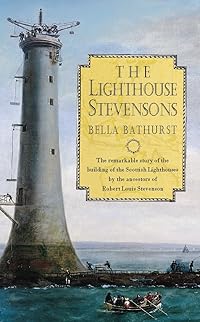The Lighthouse Stevensons by Bella Bathurst
Posted in History, Reading Reviewed, Scotland at 12:00 on 24 May 2016
Harper Collins, 1999, 304 p, including i p preface, ii p acknowledgements, i p list of illustrations, viii p introduction

Had Robert Louis Stevenson not gained such fame as a writer his surname would now be more associated with – and more widely remembered for – the astonishing achievements of his immediate forefathers, beginning with his grandfather Robert, who under the auspices of the Northern Lighthouse Trust (Scotland’s lighthouse authority, which later became the Northern Lighthouse Board) were in total responsible for the building of no less than ninety-seven lighthouses round the Scottish coast.
The first lighthouses were built against no little opposition, rescue from shipwreck being seen as thwarting God’s will and prevention as a threat to the livelihoods of those who benefited from salvage – or were, indeed, active wreckers. The technical difficulties at some of the sites were enormous, the hazard only visible at high tide, their bed-rock virtually unworkable – or both. Nevertheless, Robert built the lighthouse at the infamous Bell Rock which threatened the entrances to the Firths of Forth and Tay and the passage of shipping up and down the east coast. His sons Alan, David and Thomas respectively built at the even more difficult Skerryvore, Muckle Flugga (occasionally swept by two hundred feet high waves) and Dhu Heartach. Before finally settling on a writing career RLS, Thomas’s son – known to the family as Louis – had a hand in the construction of that last.
Patriarch Robert was a hard taskmaster and his sons – especially Alan, whose leanings towards poetry Robert regarded as suspect – relatively reluctant lighthouse builders. Alan, never in good health, was later wracked with conscience over his insistence that the men at Skerryvore should work on the Sabbath. Bathurst says of this, “The God that Scotland believes in has always been unusually retributive, quick to punish and slow to forgive, making, particularly in His more zealous, Calvinistic, manifestations a particular speciality of guilt. After his retirement Alan seems to have worshipped a uniquely Scottish God.” The lighthouse keepers were also subject to a strict code and inspection at any time (principally for untidiness indicating a general laxity and signs of, among other things, “hunnish practices.”) Very few let Robert down.
In the course of his duties Robert often travelled to London, to which he did not take. He was of the opinion that England had little except government to offer Scotland. (Perhaps coincidentally Trinity House – the lighthouse authority for England, Wales, the Channel Islands and Gibraltar – has frequently had a predatory eye on its northern counterpart.)
Bathurst incidentally sheds some light on the wider history of the Scotland of the time. Lighthouse construction gave employment in road building and the like for those affected by the Highland Clearances and the potato famine (not as devastating in Scotland partly due to government relief whose co-ordinator was the unforgettably named Sir Edward Pine Coffin.)
She also makes several asides on the peccadillos of the strange country in which these endeavours took place. “Scottish history was not generally taught to Scottish children until the 1960s” (I can attest that in some cases it did not come in till even later: apart from Iron Age brochs – safely distant in time and so not contentious – I was taught none at all; having to rely on my own background reading and absorption from the general culture) and “(Edinburgh) managed to sustain several wildly contradictory faiths: anti-Englishness and fervent Britishness; improvement and nostalgia; depression and vivacity” which is actually remarkably few contradictions for a Scottish town……
The Lighthouse Stevensons is an engrossing book on a fascinating subject. A fine tribute to all those who contributed to what even today would be daunting tasks.
Pedant’s corner:- Prince’s Street (Princes Street,) Secretary at War (Secretary of War?) canon ball (cannon,) copice (coppice,) row-boats (rowing boats,) throve (I prefer thrived,) “it was a simpler design that Winstanley’s” (than,) (John Rennie) was jointly responsible for widening the Clyde to allow for deeper hulled vessels (dredging and widening the navigable channel?) “a tangle of rocks….. with the sea beating against their sides” (against its sides,) stancheons (stanchions,) the only matter … were proceedings (was; or else, matters,) the next generation .. were appearing (was,) “holophotal meaning ‘whole light’ in Greek” (no; holophotal means ‘whole light’ in English,) “but here was no time” (there was,) supernumary (supernumerary,) “caught comprised” (compromised,) I can imagine what “hunnish practices” might mean but it isn’t spelled out (and the internet is surprisingly unenlightening on the subject.) “Then Thomas Smith began his work” (When Thomas Smith began,) the number of incidents have… (the number has.)
Tags: Bell Rock, Skerryvore, David Stevenson, Thomas Stevenson, Dhu Heartach, hunnish practices, lighthouses, Muckle Flugga, Northern Lighthouse Board, Northern Lighthouse Trust, RLS, Robert Louis Stevenson, Alan Stevenson, Robert Stevenson
